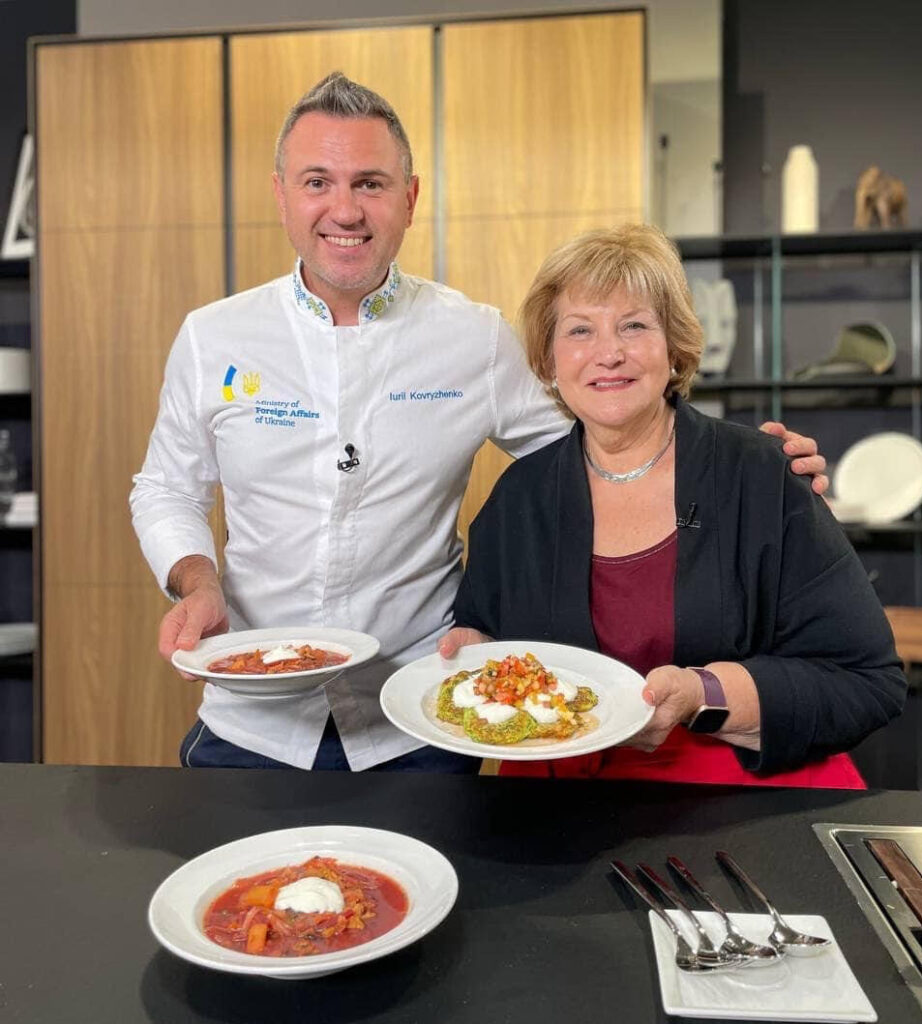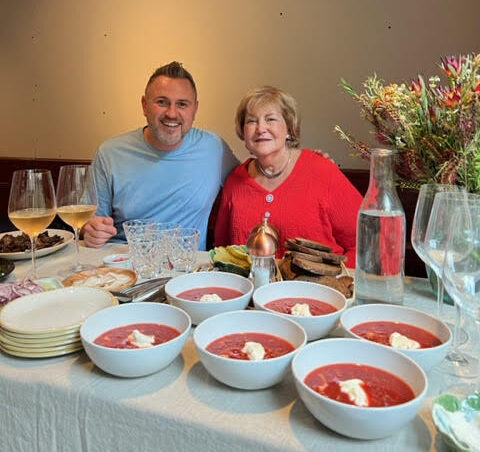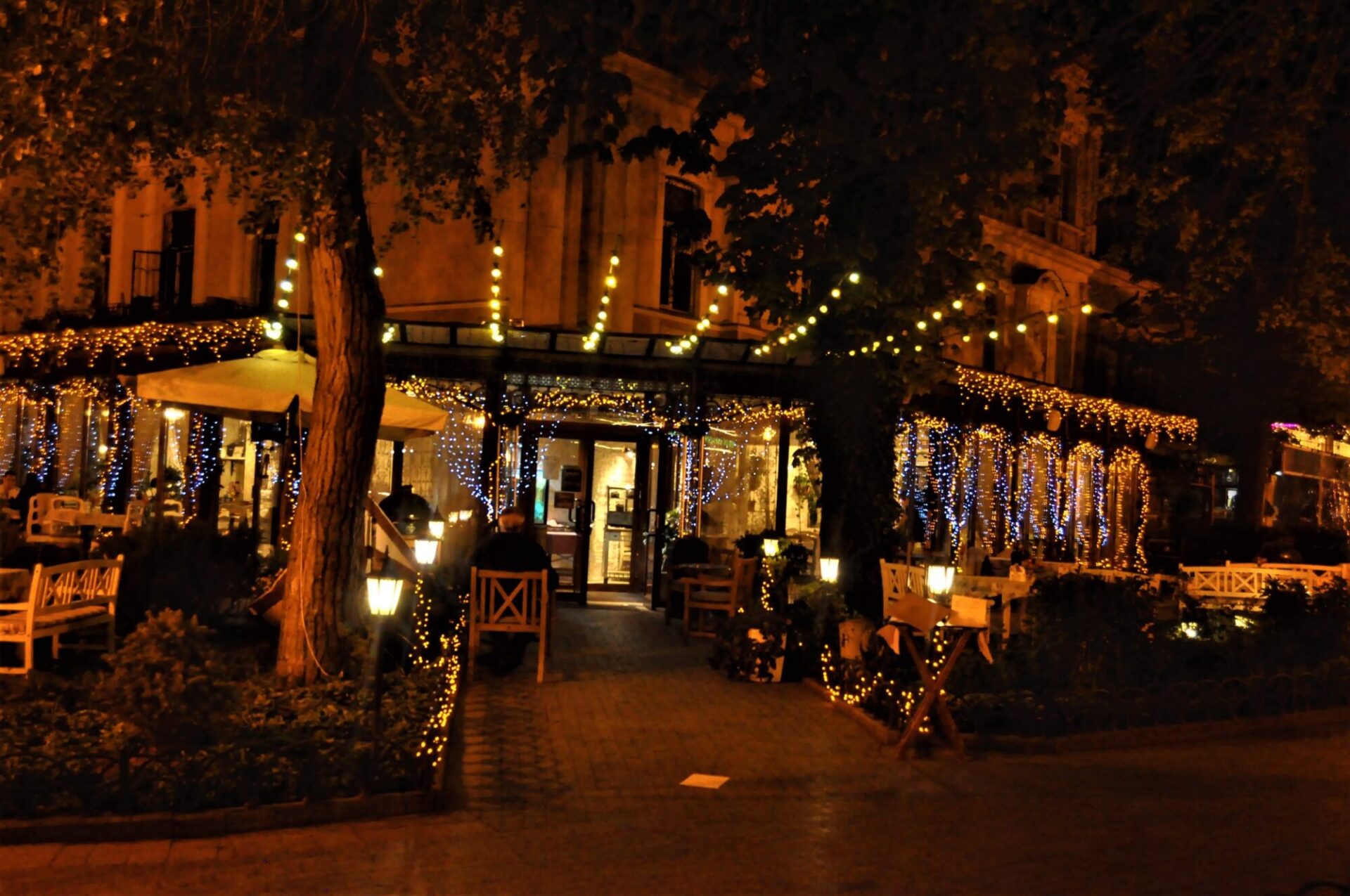It is not easy to cook in a war zone. Just look at Ukraine. But the deliberate destruction of cities cannot deprive people of their cuisine. A brutal war with Russia has converted many dining establishments across the country into soup kitchens. At least in the early days of the war, hybrid operations were started to help ensure that citizens and soldiers would receive meals.
Today, restaurants continue to support humanitarian feeding programs. For example, Yevhen Mykhaylenko, the founder of a chain of ramen restaurants, started the “Magic Food Army” charitable gastronomic fund, which prepares sandwiches, semi-finished products, and lunches for the army. And of course, World Central Kitchen, the charity started by celebrity chef José Andrés, continues to work with local chefs to ensure that food is available in multiple locations that have been hard hit by the conflict. But high-end establishments are also functioning, often in the face of adverse conditions like lack of electric power, shortages of staff, or water shortages.
Dining out has also become a patriotic duty for those who can afford it. It helps the economy while also creating a sense of community. The stress of trying to survive when the wail of air-raid sirens punctuates your daily routine is another reason people have turned to food to relieve anxiety and reconnect with comfort foods. A recent study led by Alla Petrenko-Lysak, a sociology student at Kyiv National University, explored the impact of this war on Ukrainian culinary practices. Among her conclusions was the importance of gathering at familiar restaurants to share a meal to create community.
Dining in Lviv
For Ukrainian food historian Ihor Lylo, the war with Russia has made him wonder what role food plays beyond survival. In a recent call with this former resident of Lviv, he did not miss a beat when he told me that “people need to have good news. Food fills that space. It suggests that getting to eat a meal in peace provides a respite from the daily struggles and fears that underlie each person’s life.”
As we continued to talk, it became clear that despite the daily horrors of war, it was still important to have some element of normalcy in an otherwise dystopian landscape of the war-torn cities of Ukraine.
In no way do I want to minimize the suffering when getting food in a war zone. Since the Russian invasion a year ago, Ukrainians have struggled to survive the urban and rural battlefields that are now their homes. But Lylo was right: eating while the sirens wail is considered a form of defiance. And it fills two primal needs: survival and pleasure.
Even with missiles flying overhead, chefs are cooking and customers are coming in to dine. We can only admire their courage as they continue to feed their communities and army, coming around the table to celebrate another day of life.
Lylo has not been in his home city of Lviv for the last eight months, but he is still in daily touch with friends and family who have remained. Lviv is a beautiful city with magnificent baroque churches, an opera house that matches La Scala, and broad boulevards that resemble those of other European capitals. The city was a tourist and food destination. In the fall of 2020, when I visited Lylo in his hometown, the streets were filled with visitors and chock full of restaurants and craft breweries. Signs were in both Ukrainian and English, a testimony to the cosmopolitan nature of the place and the growth of foreign tourism.
“Before the war, there were many restaurants with top chefs. Lviv looked like the capital of restaurants because there were so many new eating places,” Lylo told me. They mainly catered to visitors, but locals also enjoyed the diverse regional fare. When Lylo was not teaching history at the university, he hosted a popular weekend radio program about Ukrainian foodways.
Once the fighting started on Feb. 24, 2020, the city became a waystation of immigration. People fleeing drones and missile attacks in the east wound up in Lviv, the first stop on their road to becoming refugees. Between March and April 2022, approximately one and two million people flooded the city as they prepared for their journey west. It was overwhelming. The train station became a feeding station. Local restaurants became soup kitchens. While we have all seen charities, such as World Central Kitchen, feeding thousands of people across Ukraine, without the help of local restaurants and suppliers, it would have been impossible to produce so many meals.
But once the rhythm of war became part of daily life, the gastronomic culture shifted from the city center to the suburbs. Lylo thinks this was a good thing since it enabled restaurants to use more locally produced goods. Sustainability and supply chains were essential to keeping businesses running. Today, the biggest problem people face is not food supply, but cost. Prices rose during wartime, and the local currency collapsed. Before the war, $1 was worth 27 hryvnia; today it is worth 47 hryvnia.
Dining in Kyiv
Kyiv, Ukraine’s capital, remains under siege, with Russian drones and missiles attacking and killing civilian targets. While the Russians were not successful in capturing Kyiv at the outset of the conflict, in recent months they have ensured that the city’s electric grid was so damaged that rolling blackouts resulted. Ukrainians have overcome these hardships by using generators and jerry-rigging solutions so life could go on.
When I talked to Tetyana, a young resident of Kyiv, last week, she told me that many restaurants did not close despite the air raids and bombings. Musafir, a restaurant run by the Crimean-Tartar diaspora that opened after the Russian invasion of 2014, immediately converted its operations to supplying food for the army and civilians working with emergency services. “Every little small business supports the Ukrainian army.” She explained that right after the war started, there was a problem with access to everyday foods. People were hoarding items at grocery stores. “Food disappeared from the shelves. All you could find were luxury goods. There was plenty of lobster but no fresh fish.” That supply issue is no longer a problem. Today, almost everything is available, even McDonald’s!
When I asked about staffing the restaurants, she told me that workers were mainly university students since they were exempt from military service while getting their degrees. And everyone needs a little extra money these days. Yet, finding help remains a challenge for many eating establishments because so many men and women volunteered to serve in the military.
Tetyana described the night scene in Kyiv. She thought that because of all the blackouts, the city looked as if it might have in medieval times, with the only light on the street the tiny flicker of flashlights that pedestrians carry to find their way around. There are few taxis since so many of the drivers are now in the army. But the darkness does not deter diners. While restaurants start serving dinner at 4pm, they close early because of a curfew that is in effect. However, all kinds of crimes are on the rise. The dark streets create an opportunity for thieves to roam freely, she noted. “The danger of death is not hypothetical. People are out trying to celebrate life.”
Today restaurants in Kyiv are serving as community centers. “Sit, eat, and communicate.” They connect friends and neighbors, they have generators that allow people to have light, heat, and charge their phones. If one neighborhood does not have power, people move on to another one where there is light. But they all scurry home before the curfew begins, and another day means you have survived. Even in wartime, people still flock to high-end meals, according to my friend Mariya Ruban, a food writer and publicist. Since fall 2022, two of the city’s internationally recognized restaurants, Mirali and Chef’s Table, resumed their evening fine-dining service. A few others reopened earlier, hosting “gastronomic events” and tastings.
Today restaurants in Kyiv are serving as community centers. They connect friends and neighbors, they have generators that allow people to have light, heat, and charge their phones.
Yet, the biggest challenge to the food sector is the war itself. “Shelling means that everyone in Ukraine is always in danger. It also means that the work schedules are unpredictable.” Ruban told me a story about a drone attack in Kyiv in October 2022, which impacted most of the restaurants. The morning explosions meant that most of the restaurants did not open that day. All except one: “The tiny coffee shop Lagom, on Tsitadelna Street. During the raid, which was 5-6 blocks from my house, I saw from the window how the fearless barista opened the café, laid out the decorative pumpkins in front of the entrance, and arranged the chairs and tables of the terrace. When the air alert ended, and I went out to get my coffee, I asked the barista, ‘Weren’t’ you scared of the drones? The explosions?’ She said, ‘And what did I have to do when I arrived at work? The fact that I was working at that moment, on the contrary, it was distracting.’ I watched as the tables remained occupied all afternoon and into the night.”
The second challenge is the electric power grid. “With Russian shelling critical infrastructure, many days could go by without light.” Ruban said. She told me about how the Zavertalio pastry shop’s owner complained that the blackouts made it challenging to bake croissants. “Because electricity disappears at night, there is not enough heat to make the dough rise. Some of the batches of baked goods were spoiled.” Generators have their own issues. Fuel to run them makes it more expensive to keep the power going. There is also a limit to the power load that a generator handles. Some restaurant owners are now delaying their reopening until spring.
It is not easy to cook in a war zone. Ruban told me that in Mykolaiv, “even though this city has been through a lot and was shelled ten times harder than Kyiv, restaurants continue to work.” But these places face very difficult conditions: blown-out windows from explosions and problems with the city water supply, which have continued since April 2022. Much of the water there “is unsuitable for cooking even after filtering and boiling.” And sometimes the water supply breaks down entirely. Yet, that city’s dining establishments continue to operate, “cooking deliciously,” baking and serving up local cuisine.
Conflict Cuisine
The Ukrainian diaspora has also taken their cuisines to other cities. Yurii Korvyshenko, a chef who served as the Ukraine Foreign Ministry’s Chef Ambassador, found himself in London when the war began last February.

He decided that he needed to use his culinary platform in the Embassy of Ukraine in London to seek support from other chefs in the United Kingdom by using food as this tool of statecraft. From the embassy, he reached out to school children, inviting them to make varenyky, the famous potato stuffed dumplings, coloring the dough with blue and yellow food dye. He set up events with England’s most renowned chefs and joined in fundraising dinners in support of Ukraine’s war efforts.
Then he decided that his countrymen needed a place in London where they could enjoy his cuisine and gather safely. So Yurii started to work on Mriya (the word in Ukrainian means “dream”) in the summer of 2022, a Ukrainian restaurant that would serve the diaspora community and locals curious about the cuisine. Like so many other restaurants of diaspora communities, Mriya has become what sociologists call ethnic restaurants: the living room of the homesick. A place where the taste of such classic dishes as borsch, stuffed cabbage, and chopped herring are part of the menu. The employees are all Ukrainian, and hiring focuses on refugees who need work.

Recently, Prime Minister Rishi Sunak was able to sample Yurii’s cuisine when the restaurant got a surprise call from Downing Street to prepare a catered meal. According to Ruban, “we had to reorganize work in Mriya’s kitchen to free up people to prepare for Rishi’s feast.” It took two days of work. It was for a celebration of Orthodox Christmas and New Year’s. “We were honored to serve this reception because the United Kingdom has done much for Ukraine and its people during this difficult year.”
One year into a deadly conflict with Russia, Ukrainians continue to patronize restaurants in many Ukrainian cities to demonstrate their will to survive. Even with missiles flying overhead, chefs are cooking, and customers are coming in to dine. We can only admire the courage of so many people who continue to do their jobs, feeding their communities and their army, and coming around the table to celebrate another day of life.





















